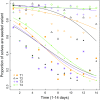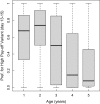Conformity does not perpetuate suboptimal traditions in a wild population of songbirds
- PMID: 28739943
- PMCID: PMC5544276
- DOI: 10.1073/pnas.1621067114
Conformity does not perpetuate suboptimal traditions in a wild population of songbirds
Abstract
Social learning is important to the life history of many animals, helping individuals to acquire new adaptive behavior. However despite long-running debate, it remains an open question whether a reliance on social learning can also lead to mismatched or maladaptive behavior. In a previous study, we experimentally induced traditions for opening a bidirectional door puzzle box in replicate subpopulations of the great tit Parus major Individuals were conformist social learners, resulting in stable cultural behaviors. Here, we vary the rewards gained by these techniques to ask to what extent established behaviors are flexible to changing conditions. When subpopulations with established foraging traditions for one technique were subjected to a reduced foraging payoff, 49% of birds switched their behavior to a higher-payoff foraging technique after only 14 days, with younger individuals showing a faster rate of change. We elucidated the decision-making process for each individual, using a mechanistic learning model to demonstrate that, perhaps surprisingly, this population-level change was achieved without significant asocial exploration and without any evidence for payoff-biased copying. Rather, by combining conformist social learning with payoff-sensitive individual reinforcement (updating of experience), individuals and populations could both acquire adaptive behavior and track environmental change.
Keywords: Parus major; animal culture; conformity; social learning.
Conflict of interest statement
The authors declare no conflict of interest.
Figures









References
-
- Muller CA, Cant MA. Imitation and traditions in wild banded mongooses. Curr Biol. 2010;20:1171–1175. - PubMed
-
- Whiten A, et al. Cultures in chimpanzees. Nature. 1999;399:682–685. - PubMed
-
- van Schaik CP, et al. Orangutan cultures and the evolution of material culture. Science. 2003;299:102–105. - PubMed
-
- van de Waal E, Borgeaud C, Whiten A. Potent social learning and conformity shape a wild primate’s foraging decisions. Science. 2013;340:483–485. - PubMed
Grants and funding
LinkOut - more resources
Full Text Sources
Other Literature Sources

